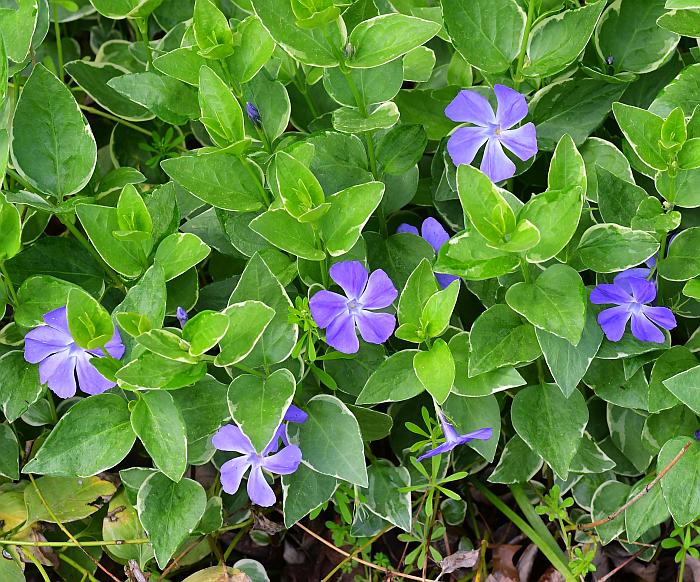Vinca major L.
Greater Periwinkle

Introduced
CC = *
CW = 5
MOC = 2
© SRTurner
Vinca major L.Greater Periwinkle | |
 |
Introduced CC = * CW = 5 MOC = 2 |
© SRTurner |
|
Family - Apocynaceae Habit - Perennial forb. Stems - Prostrate, mat forming, to 1.5 m, rooting at nodes, glabrous.
Leaves - Opposite, simple, entire, petiolate. Petioles 9-18 mm long. Blades 1.5-7.0 cm long, 0.8-5.5 cm wide, ovate to triangular-ovate, narrowed or slightly tapered to a usually sharply pointed tip, broadly rounded to truncate or shallowly cordate at the base, the smallest leaves with blades sometimes appearing angled at the base, the margins densely but inconspicuously pubescent with short, stiff, somewhat appressed-ascending hairs. Blade surfaces glabrous, often mottled with lighter shades of green.
Inflorescences - Solitary axial flowers. Peduncles 16-50 mm long.
Flowers - Calyx lobes 9-12 mm, linear, sharply pointed at the tip, glabrous or hairy. Corollas trumpet-shaped, the tube funnelform, 12-20 mm long, blue or bluish lavender, rarely white, hairy on the inner surface near the stamens, the lobes 15-25 mm long, slightly shorter than to longer than the tube, spreading, often somewhat asymmetrical toward the tip. Stamens attached toward the midpoint of the corolla tube, the anthers incurved but free from and positioned above the stigma, narrowly obovate, hairy. Nectar glands 2, positioned on opposite sides of the ovary bases. Style gradually broadened toward the tip, the stigma more or less conical, with a narrow, disclike rim or wing of tissue at the base and minute tufts of hairs at the tip and base.
Fruits - Rarely produced. Follicles 2-7 cm long, erect or ascending, relatively stout, narrowed or tapered above and below the seed(s), dehiscing longitudinally only with age. Seeds 1(2-5) per fruit, 3-7 mm long, mostly narrowly elliptic-ovate in outline, flattened, with a deep, longitudinal groove, the surface otherwise finely wrinkled, glabrous, dark brown to nearly black. Flowering - April - May. Habitat - Old homesites and cemeteries, forests. Origin - Native to Eurasia. Lookalikes - Vinca minor. Other info. - Since this species rarely produces viable fruits, its presence usually indicates former cultivation. It is less common than its close relative Vinca minor, which it strongly resembles. The two differ in several somewhat subtle aspects. Vinca major has leaves which are rounded rather than tapered at the base, finely hairy on the margins, and which have longer petioles (use a large and well-developed leaf for this comparison). The flowers are also larger and the calyx lobes longer and narrower. Photographs taken near Labadie, MO, 4-22-2006, 4-28-2019, and 4-15-2021 (SRTurner). |